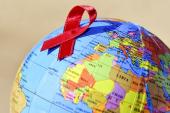Pitavastatin Cuts MACE in HIV-Infected Patients: REPRIEVE
The large CV outcomes trial, spanning 12 countries, is highly generalizable to people living with HIV, say experts.

In patients with HIV infection but without preexisting cardiovascular disease, lipid-lowering treatment results in large and significant reductions in major adverse cardiovascular events, full results of the REPRIEVE trial show.
Released this week as a late-breaking clinical trial presentation at the International AIDS Society conference in Brisbane, Australia, the study showed that pitavastatin (Livalo; Kowa Pharmaceuticals) reduced the incidence of MACE by 35% over a median follow-up of 5.1 years when compared with placebo. Additionally, pitavastatin reduced the secondary endpoint of MACE and all-cause mortality by 21% compared with placebo.
As reported by TCTMD, the study was stopped early on the basis of a preliminary analysis earlier this year; the full results was simultaneously published in the New England Journal of Medicine.
Lead investigator Steven K. Grinspoon, MD (Massachusetts General Hospital, Boston), emphasized the study’s international and diverse patient population, noting that the randomized, controlled trial spanned 12 countries, including patients from sub-Saharan Africa; South, Southeast, and East Asia; and Latin America and the Caribbean in addition to high-income countries.
“This is a large trial that is very generalizable due to its global nature,” he told TCTMD. “It’s truly an international landmark trial.”
Matthew Feinstein, MD (Northwestern University Feinberg School of Medicine, Chicago, IL), who wasn’t involved in the study, said the National Institutes of Health (NIH)-funded REPRIEVE results are truly impressive, as are the scale and duration of a primary-prevention trial in a largely underrepresented patient population.
“To enroll internationally, to increase the representativeness of the trial, that’s a big achievement,” he said. “Most importantly, the effect size was big. A 35% reduction in risk—that’s more than what you would expect for the equivalent amount of lipid lowering with a moderate-intensity statin.”
Feinstein, the lead author of a 2019 scientific statement from the American Heart Association on CVD risk in people living with HIV, said safety concerns and lack of quality evidence testing statins in HIV-infected patients simultaneously treated with antiretroviral therapy (ART) had limited the use of the lipid-lowering drugs.
“Depending on the statin, they have variable metabolism with the cytochrome P450 system,” he told TCTMD. “Several HIV medications, particularly boosters, exist to inhibit aspects of cytochrome P450 system in order to increase active drug levels. The concern was that for certain antiretrovirals, if patients were concomitantly treated with those and a statin, the relative levels of the statin might increase substantially.”
Excess CVD Risk in People Living With HIV
A number of studies in the past decade have highlighted the excess risk of atherosclerotic cardiovascular disease (ASCVD) in people living with HIV compared with uninfected people. Even in individuals with sustained HIV viral suppression, the risks of MI are significantly higher than for people without HIV infection, including in those with few or no ASCVD risk factors. Prior studies have also shown that people with HIV have an elevated risk of heart failure, an excess that isn’t entirely attributable to MI, as well as higher risks of stroke, atrial fibrillation, and peripheral arterial disease.
“We know that people living with HIV have a 50% to 100% increased risk of cardiovascular disease and that risk is not often reflected in traditional risk scoring,” said Grinspoon. “In REPRIEVE, the baseline predicted risk is very low. So, we have a population that’s young with a low predicted risk that’s having a lot of heart disease. The question is, how to prevent it?”
For REPRIEVE, statins were hypothesized as one possibility, not only because they lower LDL-cholesterol levels, but also because they decrease inflammation and residual immune activation, “which we think is driving the excess risk to some extent in people living with HIV,” he added. In JUPITER, for example, treatment with rosuvastatin reduced inflammation as measured by high-sensitivity C-reactive protein and decreased the residual risk of cardiovascular events.
Pitavastatin is a moderate-intensity statin known to lower LDL-cholesterol levels by approximately 30%, said Grinspoon. It was selected because it’s known to be safe in patients with HIV, as shown in the INTREPID trial where the drug was superior to pravastatin for reducing LDL cholesterol and inflammation. Importantly, the drug does not depend on cytochrome P450 for primary metabolism, which alleviates concerns about drug interactions with ART, he added.
A 35% reduction in risk—that’s more than what you would expect for the equivalent amount of lipid lowering with a moderate-intensity statin. Matthew Feinstein
The REPRIEVE investigators randomized 7,769 patients (mean age 50 years; 31.1% female; and 65.2% non-White) with HIV infection on stable ART at low-to-moderate CVD risk to pitavastatin 4 mg or placebo. At baseline, the median LDL cholesterol level was 108 mg/dL and the 10-year risk of ASCVD was 4.5%. Treatment with pitavastatin reduced LDL cholesterol levels to 74 mg/dL at 12 months while the median LDL cholesterol was unchanged in the placebo group.
The incidence of the primary endpoint occurred in 4.81 per 1,000 person-years in the pitavastatin group and 7.32 per 1,000 person-years in the placebo-treated patients, a significant difference. The treatment effect was consistent across subgroups, including men and women and across different global regions. There were also no differences seen in groups based on CD4 levels.
REPRIEVE: Primary and Secondary Outcomes
|
|
HR (95% CI) |
|
Primary Outcome |
|
|
First MACE (CV Death, MI, Hospitalization for Unstable Angina, TIA, Peripheral Artery Ischemia, Revascularization, or Death From Unknown Cause) |
0.65 (0.48-0.90) |
|
Secondary Outcomes |
|
|
First MACE or Death |
0.79 (0.65-0.96) |
|
Death From Any Cause |
0.90 (0.70-1.16) |
Regarding side effects, new-onset diabetes was more frequent in patients treated with pitavastatin, which is in line with data from other studies. However, even in this small group of people with diabetes, pitavastatin still had a protective effect on hard clinical outcomes, said Grinspoon. Muscle-related symptoms were also more common with statin therapy but resulted in very few patients stopping the medication for this reason (1.1%). Myopathy, rhabdomyolysis, and substantial increases in liver enzymes were rare, report investigators.
“In general, it was well tolerated and it was a really robust treatment effect, much more than we thought we’d see,” said Grinspoon. For example, based on data from the Cholesterol Treatment Trialists’ Collaboration, a 30% reduction in LDL-cholesterol levels would be expected to translate into a 17% reduction in MACE. “There’s something beyond LDL lowering that is happening here,” he said. “The change in LDL matters, but beyond that, we think it’s the reduction in inflammatory pathways.”
The REPRIEVE investigators are currently conducting a mechanistic substudy to evaluate the impact of pitavastatin on inflammatory biomarkers.
What About High-Intensity Statins?
To TCTMD, Feinstein said there are several HIV-specific factors that influence cardiovascular risk. These risk-enhancing factors include low current or nadir CD4 count (< 350 cells/mm3), which can serve as a marker of long-standing immune dysregulation and the result of which is unresolving inflammation. A history of prolonged HIV viremia and/or delays in starting ART also is a risk-enhancing factor for ASCVD.
“Prompt control of HIV and limiting CD4 decline to the extent possible, as well as limiting unsuppressed viremia as much as possible, are obviously good for HIV control, but it’s also good for curbing cardiovascular risk,” said Feinstein. Persistent viremia, CD4 decline, and changes in T-cell phenotype associated with HIV, he added, are all drivers of chronic inflammation, which is a major component of ASCVD risk.
One new question now is whether the reduction in MACE might have been larger if a high-intensity statin were used to slash LDL-cholesterol levels by roughly 50%. There’s no guidance to date as to how to treat people with HIV with preexisting ASCVD.
“That remains an unanswered question,” said Feinstein. “Would the effect size that we saw here, which was pretty substantial, be even greater with a more intensive approach to lipid lowering?” Based on the results from the general population, he suspects the answer might be yes.
The change in LDL matters, but beyond that, we think it’s the reduction in inflammatory pathways. Steven K. Grinspoon
As for whether a more potent statin would have led to even more robust reductions in outcomes, Grinspoon said they can only speculate. “We chose a statin that was very, very safe with ART,” he said. “It’s known to be a very potent anti-inflammatory. Would we have gotten more of an effect [with more potent statin therapy]? It’s possible, but I don’t know about safety.”
In an editorial, Matthew Freiberg, MD (Vanderbilt University Medical Center, Nashville, TN), credits the REPRIEVE investigators for conducting the research, noting that HIV patients are usually excluded from randomized trials. He pointed out the study included very few participants with hepatitis C infection, as well as few with psychiatric conditions and few who used drugs or alcohol. The risks and benefits of pitavastatin in such individuals will require a careful discussion because hepatitis C, unhealthy alcohol consumption, substance abuse, and depression are all risk factors for ASCVD that aren’t captured in existing risk calculators.
“In addition, it is unclear whether the benefits of pitavastatin extend to all other statin medications,” writes Freiberg. “Such drugs may be considered if availability or cost issues arise and only if these medications are not contraindicated in those receiving antiretroviral therapy.”
Feinstein, who previously performed a systematic review of statin therapy in HIV-infected patients, noted that simvastatin is contraindicated in patients taking a protease inhibitor. Pravastatin, rosuvastatin, and pitavastatin, according to that review, appeared to have the most benign safety profiles when used with ART and shouldn’t require dose adjustment. Atorvastatin also appeared safe when used at submaximal doses if monitored closely.
Michael O’Riordan is the Managing Editor for TCTMD. He completed his undergraduate degrees at Queen’s University in Kingston, ON, and…
Read Full BioSources
Grinspoon SK, Fitch KV, Zanni MV, et al. Pitavastatin to prevent cardiovascular disease in HIV infection. N Engl J Med. 2023;Epub ahead of print.
Freiberg MS. HIV and cardiovascular disease—an ounce of prevention. N Engl J Med. 2023;Epub ahead of print.
Disclosures
- Grinspoon reports grant support from Gilead Science, Kowa Pharmaceuticals, National Institutes of Health, and ViiV Healthcare. He reports consulting for Marathon Asset Management, Theratechnologies, and ViiV Healthcare.
- Freiburg reports no relevant conflicts of interest.





Comments